Sandra Danby's Blog
October 16, 2025
#BookReview ‘The Instrumentalist’ by Harriet Constable #historicalfiction #Venice
18th century Venice. A baby is posted through a hole in the wall at Ospedale della Pietà, a hospital for orphaned girls. She is one of many left there, mostly by sex workers. They are fed, educated and, if they have the aptitude, they learn a musical instrument. The Instrumentalist by Harriet Constable imagines the life story of Anna Maria della Pietà. 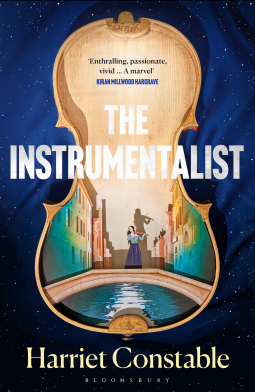 Based on a real violinist, Anna sees musical notes as colours swooping, swirling, dancing. She believes fiercely that she is special but this ferocity also makes her vulnerable. In her relationship with her music master she is looking for musical success but secretly hopes to find a father-figure. Unnamed, I assume the maestro to be Antonio Vivaldi. Little is known about the real Anna Maria and this frees Constable to imagine her life, her successes, failures, challenges and betrayals.
Based on a real violinist, Anna sees musical notes as colours swooping, swirling, dancing. She believes fiercely that she is special but this ferocity also makes her vulnerable. In her relationship with her music master she is looking for musical success but secretly hopes to find a father-figure. Unnamed, I assume the maestro to be Antonio Vivaldi. Little is known about the real Anna Maria and this frees Constable to imagine her life, her successes, failures, challenges and betrayals.
Anna is a precocious violinist at the age of eight, her ambition and zeal to succeed is familiar nowadays but I’m not sure how typical it was for an orphan in 18th century Venice. The language occasionally drifts into modern-day vocabulary and grammar. Understanding that her life can only be changed if she joins the figlie di coro, the ospedale‘s orchestra, Anna Maria becomes accomplished at playing the violin and in musical composition. There are riches to be gained when the orchestra performs, donations to the ospedale from wealthy donors, gifts for the performers. The stakes are high, girls who fail are quickly married off. Friends are sacrificed.
In places, the writing is indulgent; repetitive description is pretty but doesn’t move the story along. Two-thirds through is a different phase showing the real Venice and the dirt and injustice beneath the wealth and beauty. The perfume made of jasmine distilled in pig fat, used for a week before being discarded. The hand-made lace cuffs and handkerchiefs made in a sweatshop. Shimmering red silk and the red blood of a newly killed piglet. A reminder of the binary life of girls at the ospedale; gifts and benefits come with musical excellence, musical failure means housework, training in lacework, laundry or being sold into marriage.
An intense novel set within a constricted building in a city that is at once beautiful and threatening. Every baby girl left at the ospedale must find a way to survive in an unforgiving world but will always wonder if her mother will return to her. I finished The Instrumentalist wishing the story was broader, focussing equally on the three childhood friends, Anna Maria, Paulina and Agata and not just on Anna Maria.
If you like this, try:-
‘The Glassmaker’ by Tracy Chevalier
‘City of Masks’ by SD Sykes #3OSWALDDELACY
‘The Garden of Angels’ by David Hewson
And if you’d like to tweet a link to THIS post, here’s my suggested tweet:
#BookReview THE INSTRUMENTALIST by Harriet Constable https://wp.me/p2ZHJe-8v3 via @SandraDanby
October 12, 2025
#BookReview ‘Rainforest’ by Michelle Paver #suspense #mystery
Set in Mexico in the 1970s, Rainforest by Michelle Paver is an intoxicating mixture of unrequited love, tropical rainforest, Mayan culture, drugs and obsession. When Simon Corbett joins a scientific expedition in the South American jungle, he takes with him a strange talisman to remind him of a former love. 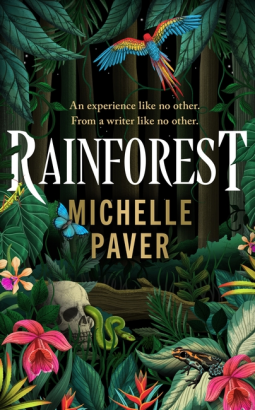 Ostensibly, Simon joins the team as entomologist, a specialist in insects, keen to find new species of mantids. He wants to get his life back, get his career on track again, face up to his demons. Really, he is running way from guilt. He feels responsible for the death of Penelope, a woman with whom he formed an attachment, though she died in a car accident when Simon was miles away. Gradually his backstory is revealed as Simon writes a journal, explores the rainforest and gets to know his fellow explorers. They’re a strange bunch with odd habits and secrets, just like Simon himself. He sees the rainforest, and his mantids, as his saviours. ‘If only I too could believe that I can contact the dead. That I could see her, touch her one last time. If only, if only, if only. That’s why I can’t sleep. That’s why I need the jungle. If anything can save me, it’s my mantids. We’re in this together, my beauties. It’s you and me against the world.’ It takes a while for the full story of Simon’s relationship with Penelope to become clear and we only ever have his side of the story.
Ostensibly, Simon joins the team as entomologist, a specialist in insects, keen to find new species of mantids. He wants to get his life back, get his career on track again, face up to his demons. Really, he is running way from guilt. He feels responsible for the death of Penelope, a woman with whom he formed an attachment, though she died in a car accident when Simon was miles away. Gradually his backstory is revealed as Simon writes a journal, explores the rainforest and gets to know his fellow explorers. They’re a strange bunch with odd habits and secrets, just like Simon himself. He sees the rainforest, and his mantids, as his saviours. ‘If only I too could believe that I can contact the dead. That I could see her, touch her one last time. If only, if only, if only. That’s why I can’t sleep. That’s why I need the jungle. If anything can save me, it’s my mantids. We’re in this together, my beauties. It’s you and me against the world.’ It takes a while for the full story of Simon’s relationship with Penelope to become clear and we only ever have his side of the story.
Paver’s description is beautiful, but always one step away, hidden by a leaf, a shadow, there is an unknown threat. Perhaps a snake, a nest of fire ants, a bullet ant, howler monkeys, a caiman, a Mayan shaman, the ghost of the shaman’s dead brother. The worst threats are in Simon’s mind, his dreams at night, his imagination. Paver has written an eerie tale encompassing unrequited love, stalking, paranoia, loneliness, social isolation and ineptness. Simon’s nightmares are so real the line begins to blur so that I question is it really happening or is he imagining everything. The rainforest is an unreal world, unsettling, easy to lose oneself in, even if you’re healthy. And Simon is definitely vulnerable. But decidedly stubborn.
Underlying it all is the how the way of life of indigenous peoples is being threatened by westerners invading their rainforest environment. At best it is a thoughtless, arrogant disregard for the native people, at worst an exploitative, abusive motivation that threatens not just the people who live in the deep jungle but the natural world, its fauna and flora, no matter how beautiful or strange. Trees are felled, habitat destroyed, artefacts stolen.
I loved the rainforest setting, the description is faultlessly fabulous. I found it more difficult to connect with Simon. At times I felt a little in despair of his self-destructive streak, a compulsion to indulge in his painful memories, always choosing the path of pain rather than the one towards recovery. Like poking a wound with a needle. Where is the threat? In the rainforest surrounding the camp on all sides, or inside Simon?
How far will a man go to avoid bad memories? The truth is wherever you go, the memories go with you and so does the danger. When you’re lost in the rainforest, something beautiful can kill you, or something invisible, or something inside your head. Michelle Paver writes brilliant ghost stories set in extreme physical conditions. The Arctic in Dark Matter and the Himalayas in Thin Air, both are 4* books for me; and the 5* Wakenhyrst set beside the bleak East Anglian fens. All of them play with the concept of what is real and what is imagined. If it’s not real, does that means it’s not dangerous?
Very good. Though I didn’t particularly like Simon, I was still thinking about him days after finishing the book.
And read my reviews of these other novels by Michelle Paver:-
THE OUTSIDERS #1GODS&WARRIORS
THIN AIR
VIPER’S DAUGHTER #7WOLFBROTHER
WAKENHYRST
If you like this, try:-
‘The Snakes’ by Sadie Jones
‘The Hoarder’ by Jess Kidd
‘The Ice’ by Laline Paull
And if you’d like to tweet a link to THIS post, here’s my suggested tweet:
#BookReview RAINFOREST by Michelle Paver https://wp.me/p2ZHJe-8uH via @SandraDanby
October 8, 2025
Great Opening Paragraph 141… ‘David Copperfield’ #amreading #FirstPara
“Whether I shall turn out to be the hero of my own life, or whether that station will be held by anybody else, these pages must show. To begin my life with the beginning of my life, I record that I was born (as I have been informed and believe) on a Friday, at twelve o’clock at night. It was remarked that the clock began to strike, and I began to cry, simultaneously.”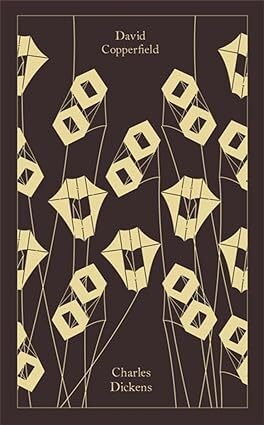 From ‘David Copperfield’ by Charles Dickens
From ‘David Copperfield’ by Charles Dickens
Here’s the #FirstPara of another novel by Charles Dickens:-
A TALE OF TWO CITIES
Try one of these 1st paras & discover a new author:-
‘Affinity’ by Sarah Waters
‘Death in Summer’ by William Trevor
‘1984’ by George Orwell
And if you’d like to tweet a link to THIS post, here’s my suggested tweet:
#FirstPara DAVID COPPERFIELD by Charles Dickens #books #amreading https://wp.me/p2ZHJe-7gC via @SandraDanby
October 6, 2025
#BookReview ‘Precipice’ by @Robert_Harris #WW1 #thriller
A gripping, page-by-page account of the prelude to war interleaved with the secret letters and snatched meetings of a forbidden relationship between the prime minister and a young society woman. I read Precipice by Robert Harris over a weekend, resenting anything that forced me to set the book aside. 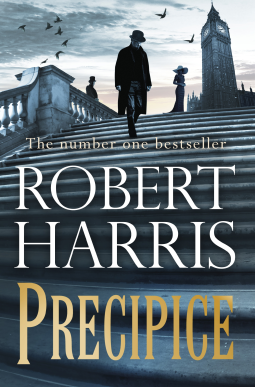 That the man involved is Prime Minister Herbert Asquith, that the story starts in the days preceding the declaration of war against Germany, that the fictional account is based on truth, all adds to the frisson. Harris is a master storyteller used to creating a fictional thriller based on historical fact. It ceased to matter what was true and what was made up, Harris puts us inside the private worlds of Asquith and Lady Venetia Stanley at a time of national danger. We all know how the war begins and ends but I didn’t know the details of the Asquith/Stanley affair or the level of reckless sharing by Asquith of privileged information; using ordinary post, top secret telegrams thrown from car windows. ‘That was a kind of madness.’ Letters were written, sent, received and replied to, with such speed and in such volume as to resemble a frantic exchange of emails or texts between lovers today.
That the man involved is Prime Minister Herbert Asquith, that the story starts in the days preceding the declaration of war against Germany, that the fictional account is based on truth, all adds to the frisson. Harris is a master storyteller used to creating a fictional thriller based on historical fact. It ceased to matter what was true and what was made up, Harris puts us inside the private worlds of Asquith and Lady Venetia Stanley at a time of national danger. We all know how the war begins and ends but I didn’t know the details of the Asquith/Stanley affair or the level of reckless sharing by Asquith of privileged information; using ordinary post, top secret telegrams thrown from car windows. ‘That was a kind of madness.’ Letters were written, sent, received and replied to, with such speed and in such volume as to resemble a frantic exchange of emails or texts between lovers today.
Harris’s genius is to add the fictional character of young policeman Detective Sergeant Paul Deemer, a new recruit at Special Branch, who is charged with looking into the torn remnants of secret Government documents found in the road and handed in by a member of the public. Deemer adds the element of risk that the story needs, a sense of danger as the sergeant uses old-fashioned policing technique – asking questions, following leads, covert surveillance, gathering evidence – in the chase to uncover the truth. Meanwhile, uncannily accurate comments about military matters are appearing in the Daily Mail. From where is the newspaper getting its information? Is the Prime Minister blinded by love? Is he incompetent, perhaps a traitor? Or is someone close to him a spy?
This is a political story about war, about ambition, obsession, showing government tensions at the most pressurised time possible as the country faces tremendous change. I turned to Harris after an unsatisfactory attempt to read another novel, it was like gulping water at a time of extreme thirst.
Read my reviews of these other thrillers, also by Robert Harris:-
AN OFFICER AND A SPY
MUNICH
V2
If you like this, try:-
‘Life Class’ by Pat Barker #LIFECLASS1
‘The Warm Hands of Ghosts’ by Katherine Arden
‘The Lie’ by Helen Dunmore
And if you’d like to tweet a link to THIS post, here’s my suggested tweet:
#BookReview PRECIPICE by
@
Robert_Harris https://wp.me/p2ZHJe-8ub
via @SandraDanby
October 2, 2025
#BookReview ‘The French for Murder’ by @BrightVerity #cosymystery #crime
A glamorous movie set and an even more glamorous it-crowd are not what Lady Eleanor Swift expects to find in the South of France. But from day one of their holiday at an exclusive rented villa, amateur detective Ellie and her butler sidekick find themselves embroiled in murder once again. The French for Murder by Verity Bright includes a new cast of glamorous Americans, mysterious Frenchmen and the gorgeous Mediterranean coast. 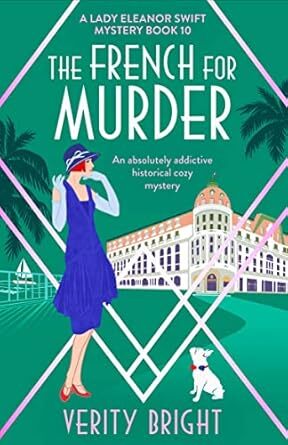 The tenth book in the 1920s cosy mystery series revolves around a film about Napoleon being shot at a nearby chateau, a dead body in Ellie’s wine cellar, a deliciously flamboyant police detective and a variety of arrogant, talented, partying movie stars, artists and hangers-on. But although the villas – and the casino at Monte Carlo – are top notch luxury, there is something rotten beneath the beauty.
The tenth book in the 1920s cosy mystery series revolves around a film about Napoleon being shot at a nearby chateau, a dead body in Ellie’s wine cellar, a deliciously flamboyant police detective and a variety of arrogant, talented, partying movie stars, artists and hangers-on. But although the villas – and the casino at Monte Carlo – are top notch luxury, there is something rotten beneath the beauty.
The murder is hushed up by the local mayor who fears damage done to the reputation of the Côte d’Azur as a budding movie location. If the truth about murder gets out, the new American tourists will holiday elsewhere. So Ellie agrees to gather clues. But after successive all-night parties involving over-the-top extravagance, alcohol and illegal substances, and beachfront sunbathing soirees with the briefest of swimwear, she is at a loss. Love, jealousy, betrayal, blackmail, money; can Ellie discover the real reason for the death of the leading man before the murderer kills again. Does the answer lay with the cast of Napoleon or is that too obvious. The two most suspicious people clearly have something to hide but lack an obvious motivation for murder and everyone else, being actors, are talented dissemblers.
The French for Murder is another delicious helping of the talented detecting duo. Ellie and Clifford are as indefatigable, brave and curious as ever, Ellie’s gowns and beach attire are impressively glamorous and the descriptions of Mrs Trottman’s pastries made me feel hungry. And as always, in each book in the series we learn more information about the backgrounds of Eleanor and Clifford.
Excellent, again.
Read my review of other books in the Lady Eleanor Swift series:-
A VERY ENGLISH MURDER #1LADYELEANORSWIFT
DEATH AT THE DANCE #2LADYELEANORSWIFT
A WITNESS TO MURDER #3LADYELEANORSWIFT
MURDER IN THE SNOW #4LADYELEANORSWIFT
MYSTERY BY THE SEA #5LADYELEANORSWIFT
MURDER AT THE FAIR #6LADYELEANORSWIFT
A LESSON IN MURDER #7LADYELEANORSWIFT
DEATH ON A WINTER’S DAY #8LADYELEANORSWIFT
A ROYAL MURDER #9LADYELEANORSWIFT
If you like this, try:-
‘The Marlow Murder Club’ by Robert Thorogood #1MARLOWMURDERCLUB
‘A Cornish Seaside Murder’ by Fiona Leitch #6NOSEYPARKER
‘The Secret Detective Agency’ by Helena Dixon #1SECRETDETECTIVEAGENCY
And if you’d like to tweet a link to THIS post, here’s my suggested tweet:
#BookReview THE FRENCH FOR MURDER by @BrightVerity https://wp.me/p2ZHJe-8pL via @SandraDanby
September 26, 2025
#BookReview ‘The Stranger’s Companion’ by Mary Horlock #mystery #suspense
A fascinating premise. A small, isolated island, the abandoned clothes of a man and a women found on a beach, no missing people. The Stranger’s Companion by Mary Horlock, set on the island of Sark, starts with a mystery based on true fact but merges into a blend of Mary Stewart and Agatha Christie. 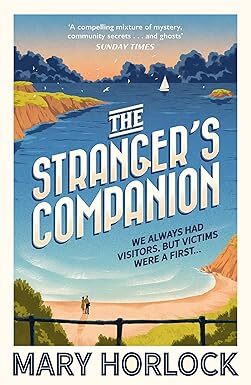 The Stranger’s Companion is a ghost story set in a place where folklore is just below the surface, a story of two teenagers who meet again as adults and the history that lies between them, a disappearance story that spreads from regional to national newspapers. The story is unveiled in two timelines, 1923 and 1933, that uneasy inter-war period occupied by ghosts of the Great War and premonitions of 1939. Sark’s bleak geography adds to this; towering cliffs that fall to the sea, stark weather, empty space, the island almost divided in two by La Coupée, a thin isthmus of rock connecting Big Sark and Little Sark, a dangerously exposed footpath.
The Stranger’s Companion is a ghost story set in a place where folklore is just below the surface, a story of two teenagers who meet again as adults and the history that lies between them, a disappearance story that spreads from regional to national newspapers. The story is unveiled in two timelines, 1923 and 1933, that uneasy inter-war period occupied by ghosts of the Great War and premonitions of 1939. Sark’s bleak geography adds to this; towering cliffs that fall to the sea, stark weather, empty space, the island almost divided in two by La Coupée, a thin isthmus of rock connecting Big Sark and Little Sark, a dangerously exposed footpath.
The start is slow, confusing because the two timelines involve the same two teenagers, Phyll and Everard, and it all swirls into one so 1923 and 1933 merge. The voice switches back and forth between different people, adding to the feeling of disorientation and the uncertainty about what is real. There is an undisputed oddness to the tale, things sensed, people glimpsed, strange noises, unexplained happenings. There are rumours of witches. And then there is the tale of the Stranger Woman, a female ghost always dressed in white.
It took a while to separate out the omniscient narrator from the various 1923 and 1933 voices. Phyll is an observer, at the edge of things, as a teenager she loves stories, true stories, ghost stories, her own inventions. As an adult she writes stories, news and fictional. I was less clear about Everard, a visitor rather than resident, but who clearly has secrets to hide. At times the disappearance of the unidentified couple, the owners of the clothes, is lost in the spooky atmosphere, vanishings, unexplained appearances, old stories. As the narrator says, ‘Doesn’t everyone love a ghost story? It means the ending is never that, because life continues, just in a new shape or form. We could argue that every story is a ghost story, because once a tale is told, it is over, it is past. All we can do is keep going back over it, to for from the end back to the start.’
I found the mystery more intriguing than the characters and remained slightly confused to the end about the historical connections and who was who. Perhaps too difficult themes are tackled in too many sub-plots, but at its heart is a most surprising secret. Sark is probably the most important presence in the book. A great promotion of the island. Despite its ghostly history, this novel made me want to visit the real place.
Here’s my review of THE BOOK OF LIES, also by Mary Horlock.
If you like this, try:-
‘The Lamplighters’ by Emma Stonex
‘Foxlowe’ by Eleanor Wasserberg
‘Thornyhold’ by Mary Stewart
And if you’d like to tweet a link to THIS post, here’s my suggested tweet:
#BookReview THE STRANGER’S COMPANION by
Mary Horlock
https://wp.me/p2ZHJe-8rQ via @SandraDanby
September 23, 2025
#BookReview ‘The Secret History of Audrey James’ by Heather Marshall #WW2
The Secret History of Audrey James by Heather Marshall sat for some time on my Kindle before I read it. It’s a World War Two story, a period which fascinates me, so why did I delay? On reflection I think it was because the story of Audrey James is inspired by historical fact. I’ve been disappointed in the past by novels where a fictional story is unexplored because the author sticks too close to the truth. I needn’t have worried.  Audrey James is based on a real woman but Audrey herself is fictional. Marshall uses the truth as inspiration to creative a novel that’s impossible to put down. I read this, at times harrowing, novel quickly. It is told in two timelines, Germany in 1938-1945 and Alnwick, England 2010. In 1945 at the end of the war, a troop of Canadian soldiers have just liberated a Dutch village. As they play cards, they notice a bedraggled woman walking towards them, her dress is torn, she is missing a shoe. This is Audrey James and this is the story of her war and her role in the German resistance which fought against Hitler.
Audrey James is based on a real woman but Audrey herself is fictional. Marshall uses the truth as inspiration to creative a novel that’s impossible to put down. I read this, at times harrowing, novel quickly. It is told in two timelines, Germany in 1938-1945 and Alnwick, England 2010. In 1945 at the end of the war, a troop of Canadian soldiers have just liberated a Dutch village. As they play cards, they notice a bedraggled woman walking towards them, her dress is torn, she is missing a shoe. This is Audrey James and this is the story of her war and her role in the German resistance which fought against Hitler.
In pre-war Berlin, British teenage pianist Audrey is living with her German friend Ilse Kaplan while she studies at the conservatory. On one day, their world changes. Ilse’s family are arrested and the house is requisitioned by two Nazi officers. Without anywhere else to go and no money, the two girls must react quickly. Ilse, who is Jewish, hides in the attic while Audrey becomes housekeeper for the two men. As war approaches, Audrey’s father in England writes telling her to come home. But Audrey is unable to leave Ilse despite being in danger herself.
In London in 2010, Kate Mercer is packing up her possessions. She and her husband are divorcing and, after the recent loss of her parents, Kate is seeking a new start. Drawn to a hotel in the North of England where her parents went on honeymoon, Kate puts the dog in the car and drives to Alnwick. She has a new job, as assistant administrator at the Oakwood Hotel. Very quickly Kate knows she’s made a mistake. The elderly owner of the hotel is grumpy, unwelcoming and very old. The two women are alone in the house during winter, both are secretive and defensive. Why does Kate feel guilty? And who is her elderly employer?
The twists and turns of this story are unpredictable and that’s what kept me reading. Audrey is prepared to do anything to keep Ilse safe. When she has the opportunity to join the Red Orchestra, a resistance group, she doesn’t hesitate. Her bravery is breathtaking. Audrey’s story is told in two phases, woven into Kate’s modern-day life. There are universal themes of love and loss, forgiveness and survival, both during wartime and many decades after.
This is a fascinating portrayal of the role of women in wartime, their bravery, ingenuity and determination. Canadian writer Marshall also writes about the strength of women in her previous novel Looking for Jane, which is now added to my To-Read list.
Excellent.
If you like this, try:-
‘The Collaborator’s Daughter’ by Eva Glyn
‘Homeland’ by Clare Francis
‘The Last Lifeboat’ by Hazel Gaynor
And if you’d like to tweet a link to THIS post, here’s my suggested tweet:
#BookReview THE SECRET HISTORY OF AUDREY JAMES by Heather Marshall https://wp.me/p2ZHJe-8pv via @SandraDanby
September 18, 2025
#BookReview ‘The Briar Club’ by @Kate_Quinn #thriller #mystery
Oh what a tangle this story is, in a good way. The Briar Club by Kate Quinn is about the women renting rooms at Briarwood House, a down-at-heel all-female boarding house in Washington DC. Starting off as a group of individuals, they slowly bond at their Thursday supper night. 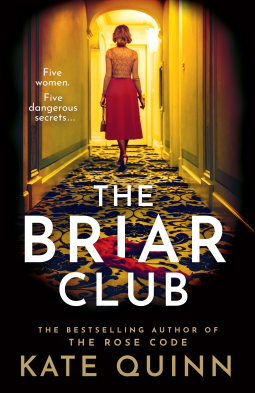 The story starts on the night Thanksgiving in 1954 with a prologue in the voice of the house. There’s a dead body in the attic and there is blood everywhere. Police are questioning witnesses. The narrative then backtracks four years. Set in the post-war McCarthy era when communists are reported by friends, family, neighbours and colleagues, at the time of this story no one feels immune from threat of denunciation. Not Bea, the former baseball player with a dodgy knee. Not Fliss, mother of baby Angela, both waiting for Fliss’s doctor husband Dan to come home from the Korean war. Not Nora, secretary at the National Archives, whose police officer brother steals her rent money.
The story starts on the night Thanksgiving in 1954 with a prologue in the voice of the house. There’s a dead body in the attic and there is blood everywhere. Police are questioning witnesses. The narrative then backtracks four years. Set in the post-war McCarthy era when communists are reported by friends, family, neighbours and colleagues, at the time of this story no one feels immune from threat of denunciation. Not Bea, the former baseball player with a dodgy knee. Not Fliss, mother of baby Angela, both waiting for Fliss’s doctor husband Dan to come home from the Korean war. Not Nora, secretary at the National Archives, whose police officer brother steals her rent money.
At first The Briar Club seems long and languorous, taking its time to tell the background story of each female lodger one at a time. This is a clever device that first shows each woman as the others see them, the assumptions made, prejudices assumed, judgements taken; then the real person is revealed in their own viewpoint, the experiences that made them who they are today, the twists and turns of life that made them behave and speak as they do. But then there is a dead body in the attic apartment and the tangles become twisted, knotted and dangerous to everyone. Is it a lover’s tiff or something more sinister? Is it the reds? This is the time of the HUAC [House Un-American Activities Committee] investigations, set against a rough Washington background of gangsters, sleaze, knife crime and wife-beating. The Thursday night Briar Club get-together gives the women a safe place to be themselves.
The first voice we hear in 1950 doesn’t belong to one of the lodgers but to Pete Nilsson, son of the landlady. When Pete is on the front stoop mending the screen door, he is interrupted by a tall woman wearing a red beret. She enquires about a room to rent and 13-year old Pete instantly falls in love. Grace March takes the dingy room, as big as a shoebox with dull green walls. Grace is the sun around which the lodgers and the story revolve. She is both at the centre of everything, seemingly all-knowing, all-seeing, but remaining an enigma. It is Grace who suggests a Thursday night supper club, it is Grace who encourages the other ladies to club together to buy spectacles for Pete’s younger sister Lina, and it is Grace who first encourages Lina’s attempts at baking despite the frequent burnt offerings. She is the bringer of light and flowers into a grubby house, the one who notices everything and knows how to keep a secret.
The stately telling of a complicated story, slow for the first 60% until the strands become entwined, character connections are made and deeply-held secrets and opinions are unveiled. From the beginning this is a consummate picture of the lives of women in 1950s Washington DC at the time of the communist witch hunts. Opportunities for women are changing post-war though many are still trapped by marriage, racism, expectations and low wages. The story starts with a mystery that becomes consuming as the paths of the fictional women cross with real-life historical people and events. And I loved that the house is given its own voice, because Briarwood House too seems a member of the Briar Club.
Very good. Slower in parts than the other Quinn novels I’ve read. All are different and I’ve enjoyed every one of them. The Briar Club morphed from a 4* to a 5* towards the end as I realised I wanted to go back to the beginning and start all over again.
Here are my reviews of two other novels by Kate Quinn:-
THE DIAMOND EYE
THE ROSE CODE
If you like this, try:-
‘Shrines of Gaiety’ by Kate Atkinson
‘Before the Fall’ by Noah Hawley
‘The Chase’ by Ava Glass #1ALIASEMMA
And if you’d like to tweet a link to THIS post, here’s my suggested tweet:
#BookReview THE BRIAR CLUB by @Kate_Quinn https://wp.me/p2ZHJe-8mt via @SandraDanby
September 13, 2025
#BookReview ‘The Midnight Feast’ by Lucy Foley #mystery #suspense
I’m at a loss how to describe the plot of The Midnight Feast, the latest mystery suspense story by Lucy Foley, without giving away anything critical. It is dark, it is gothic, there is West Country paganism, teenage friendship, spite and a bit of romance set at an ultra-glamorous cliff-top hotel in Dorset which opens at midsummer.  Told in three timelines. In 2025 as The Manor, described as ‘Soho Farmhouse meets Daylesford Organics,’ opens its doors to guests. At the same location fifteen years earlier when the house was occupied by a retired Government chief whip and his wife. And again in 2025, the day after the opening night party, billed as a midnight feast with mystery musical guests, art in the gardens and a Midsommar theme inspired by the folk horror film.
Told in three timelines. In 2025 as The Manor, described as ‘Soho Farmhouse meets Daylesford Organics,’ opens its doors to guests. At the same location fifteen years earlier when the house was occupied by a retired Government chief whip and his wife. And again in 2025, the day after the opening night party, billed as a midnight feast with mystery musical guests, art in the gardens and a Midsommar theme inspired by the folk horror film.
This is a clever thriller juggling timelines and character arcs, at the heart of which is a them v us dynamic between the house and the locals. People are not who they claim to be, the fun is working out who is who. Untangling the true identities of Francesca Meadows, hotel owner, her guest, staff and villagers is a continuing puzzle as I tried to connect the 2025 and 2010 storylines together. There are a lot of characters to keep track of.
During the summer solstice of 2010, a teenage girl on holiday with her family at a caravan park in Dorset meets a rich girl who is cooler and more confident than her and wants to be her friend. The events of that summer, romance, manipulation, bullying, drugs and death have repercussions on everyone there. The bird theme is a creepy folklore thing attributed to the local villagers, a kind of vigilante group who dress up in black bird costumes to impose justice on wrongdoers. On midsummer night, the birds come into their own.
Francesca the hotelier is a control-freak Goop-influenced woman who sells a lie; locally grown organic produce, for example, that is bought-in from London not grown locally or on the hotel’s organic veg plot. Her husband Owen is a fitness-obsessed architect responsible for developing the woodland retreat lodges, set in the hotel grounds. She doesn’t know he’s installed a tracker on her mobile phone, he doesn’t know she commissioned hidden cameras throughout the hotel. There are loads of secrets, over-the-top opulence, silliness and eerie things happening in the woods. And there is murder.
The hotel’s setting next to ancient woodland adds a gothic darkness to this thriller that is a welcome relief from the champagne, meditation and crystals. I found it a little slow at the beginning but once the guests arrive and the midnight feast approaches, the pace takes off.
An entertaining thriller which kept me guessing, it’s not just a whodunnit but who-was-it-done-to.
Click the title to read my reviews of these other novels by Lucy Foley:-
THE GUEST LIST
THE INVITATION
THE PARIS APARTMENT
If you like this, try:-
‘The Last of Us’ by Rob Ewing
‘The Snakes’ by Sadie Jones
‘Summer House with Swimming Pool’ by Herman Koch
And if you’d like to tweet a link to THIS post, here’s my suggested tweet:
#BookReview THE MIDNIGHT FEAST by Lucy Foley
https://wp.me/p2ZHJe-8o0 via @SandraDanby
September 8, 2025
#BookReview ‘The Heretic’s Mark’ by SW Perry @swperry_history #historical #crime
The Jackdaw Mysteries by SW Perry are fantastic stories and The Heretic’s Mark, fourth in the series, is a twisty unpredictable story full of suspense. When the Queen’s physician is executed for treason, Nicholas Shelby is accused anonymously of being part of the plot. Nicholas and new wife Bianca flee abroad, unsure if they can ever return to England. 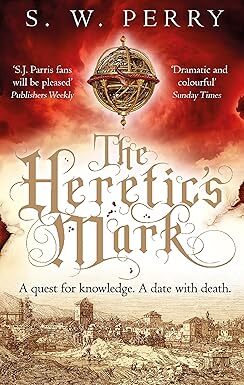 Their first destination is Den Bosch in the Low Countries where, helped by Jan van der Molen, skipper of the herring boat which is their means of escape from England, they have time to draw breath. But it seems nowhere is far enough from forces wanting to lock them up. While Bianca says confession to a priest in the cathedral, Nicholas wanders into a side chapel he comes across a triptych, a three-panelled painting which presents a scene of horror. This is ‘The Last Judgement’ by Hieronymus Bosch. Though a practical man of science, the religious horror portrayed in the painting turns Nicholas to ice. Then a woman screams and two men are dead.
Their first destination is Den Bosch in the Low Countries where, helped by Jan van der Molen, skipper of the herring boat which is their means of escape from England, they have time to draw breath. But it seems nowhere is far enough from forces wanting to lock them up. While Bianca says confession to a priest in the cathedral, Nicholas wanders into a side chapel he comes across a triptych, a three-panelled painting which presents a scene of horror. This is ‘The Last Judgement’ by Hieronymus Bosch. Though a practical man of science, the religious horror portrayed in the painting turns Nicholas to ice. Then a woman screams and two men are dead.
This is the trigger for Nicholas and Bianca to flee from Den Bosch, south along the Via Francigena, a pilgrim trail which ends in Rome. They take with them the young woman who screamed in the cathedral, a serious, proselytizing Hella Maas. Nicholas feels sympathy for her, her hard life, the death of her family. Bianca is impatient with her doom-laden words, her prophecies of doom, and questions her motivations. And so the odd trio make the road trip south, across the Alps. Once in Italy they part ways, Hella Maas to continue to Rome, the Shelbys to Padua, Bianca’s birthplace. The road journey takes up a lot of the story and, for my taste, could be more concise but it includes important foreshadowing of the eventual mystery; who is pursuing Nicholas and why. The answer is something I suspected but was unable to explain why.
Arriving in Padua, Bianca is reunited with her cousin Bruno Barrani, so introducing the sub-plot featuring Bruno and his attempts to make an armillary sphere for the city of Venice. He has raised the money and found the craftsmen, but scorns the accusations of heresy. At first this storyline seems so disconnected from the main plot to be superfluous, but in the last chapters the stories entwine. I found the third sub-plot, of Bianca’s servants Rose and Ned Monkton who stay in London to run the Jackdaw inn, riveting. Ned, determined to discover who wrongly condemned his master of treason, investigates a vague lead which brings him to the College of Physicians. Rose, pregnant with their first baby, wills him to be peaceful. Unfortunately the gentle giant is arrested for murder and sent to the Marshalsea prison.
Another good book from SW Perry who has quickly become a favourite. The next Jackdaw mystery is The Rebel’s Mark.
Note: I enjoyed the passing references to Giordano Bruno, the former Italian monk turned heretic and philosopher who features in the historical series by SJ Parris. If you haven’t read it yet, the first book is Heresy [there’s a link to my review below].
Here are my reviews of the first three books in the series:-
THE ANGEL’S MARK #1JACKDAWMYSTERIES
THE SERPENT’S MARK #2JACKDAWMYSTERIES
THE SARACEN’S MARK #3JACKDAWMYSTERIES
If you like this, try:-
‘Heresy’ by SJ Parris #1GIORDANOBRUNO
‘Dark Aemilia’ by Sally O’Reilly
‘The Whispering Muse’ by Laura Purcell
And if you’d like to tweet a link to THIS post, here’s my suggested tweet:
#BookReview THE HERETIC’S MARK by SW Perry @swperry_history https://wp.me/p2ZHJe-8jp via @SandraDanby
Sandra Danby's Blog
- Sandra Danby's profile
- 32 followers












